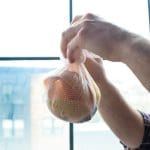Gin is essentially a flavored vodka infused with various herbs — most notably juniper berries — which give gin its signature flavor. The gin we buy is first distilled into a spirit, then redistilled with the flavouring botanicals. Gin can be made at home by simply infusing a neutral spirit like vodka with botanicals. This is called a compound gin, and though it may not be as good as some high end store-bought gin, you can make it all your own, creating a final product that suits your personal palate.
DIY gin is fun whether you’re a gin enthusiast or just stuck with a bottle of vodka you don’t want. I only found out about compound gins recently when my friend gave me a bunch of ingredients for Christmas and said, “Make some gin.” So I turned to the internet which offered a great deal of advice and recipes for a tasty compound gin. I wanted something that would not just be an ordinary gin, but something that I can’t necessarily buy off the shelf.
I also wanted something that wouldn’t take too long. For example, one recipe called for letting the infused gin set for several months, which I’m sure helps the flavor, but when other recipes only require a few days it didn’t seem important to have to wait that long. When I found a recipe that caught my eye, I played around with it adding items like star anise (which I saw in other recipes and happened to have) and adjusted amounts since I bought less vodka than the recipe called for. Don’t be afraid to stray from recipes, since some ingredients might be harder to come by or cost more than you’re willing to spend. I used the recipe I found mostly as a guide.
There are other methods people used for infusing that you can try. Some use a cheesecloth to hold the ingredients, while others put it straight into the neutral spirit and strain it afterwards. Others even went so far as to use a Brita filter to filter out the sediment left behind from the botanicals. It depends on how much work you’re looking to give yourself. I opted for the cheesecloth method because it reduces the amount of sediment, making it much easier to work with, especially since it was my first time doing it.
This is what my DIY gin recipe ended up being:
Materials:
-pitcher
-cheesecloth
-measuring spoon
Ingredients:
-2, 750mL bottles vodka (Original recipe called for 1.75 L bottle, but I only bought one 750 mL thinking it was all I needed. However, I felt I underestimated the potency of ingredients I used and added a second one)
-1.5 tbsp juniper berries
-.25 tsp coriander seeds
-.25 tsp fennel seeds
-2 cloves
-1 pod star anise
-1 peel grapefruit
-1 peel lemon
-1 peel orange
Bind botanicals and peels in a cheesecloth and place in a pitcher, mason jar, or bowl. Pour vodka over the bundle. Let sit and infuse for three days in a dark place. Be warned though, the liquid will change color, so don’t be alarmed.
The Outcome:
Checking in on the infusion after two days, it tasted more of citrus than juniper, so more juniper was thrown in and was left to infuse for a few more days. It still tastes heavily of citrus, meaning it tastes good but not as much gin flavor as I’d like. In the future I will add more juniper and less citrus. It’s also a good idea to have separate cheesecloth for the herbs and the citrus peels. That way I could’ve just removed the citrus and let the other ingredients do their work.
It definitely tastes better than the vodka is started as though, and that’s what matters, given that I used low to middle quality vodka. Obviously higher end, 100 proof vodka will yield better results, but if you’re left with some low end product after throwing a party or something, this is a creative way to turn it into something tastier.
Photographs courtesy of Olya Bahrynivska.
Here are some sites that provide infusion recipes:
http://liquor.com/articles/your-house-gin/
http://www.gourmet.com/winespiritsbeer/2008/10/homemade-gin
http://www.thepauperedchef.com/2010/02/homemade-compound-gin-no-bathtub-required.html
Writer/Blogger at The Digest. Lifelong New Jersey resident. Actually likes this place.
- Sebastian Krawiechttps://thedigestonline.com/author/sebastian/
- Sebastian Krawiechttps://thedigestonline.com/author/sebastian/
- Sebastian Krawiechttps://thedigestonline.com/author/sebastian/
- Sebastian Krawiechttps://thedigestonline.com/author/sebastian/









